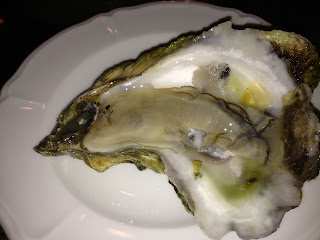 |
| Antique oyster plate collection Fran and Carol Drury. Wilmington, NC Plates circa 1850-1890 |
The Victorian era gave us lettuce forks, horseradish spoons, lemon picks, tomato servers, bacon forks, marrow scoops, baked potato tines and cake breakers solely for cutting egg white cakes. So, of course, a plate designed specifically to serve oysters in the dining room would not only be plausible, but necessary - the oyster shells would scratch the porcelain plates and that simply would not do.
While I know a little something about oysters and oyster shuckers, I knew nothing about oyster plates. So I invited myself to Fran and Carol Drury's house for a visit and a tutorial. They have been collecting for the last 20 years and have acquired a thoughtful assemblage of antique oyster plates.
Here's the basics:
 |
| Bottom of plate designed for sitting on plate of ice |
TYPES OF OYSTER PLATES
- Serving oysters on the half shell with ice
- Serving oysters on the half shell without ice
- Serving oysters sans shell, directly on the plate
OYSTER PLATE MAKERS
- Union Porcelain Works (America)
- Quimper (France)
- Haviland and Co. (Limoges, France)
- Minton (England)
- Wedgwood (England)
- George Jones & Sons (England)
- Longchamps (France)
GETTING STARTED
The Drurys started collecting oyster plates to help solve a problem many couples have - she wanted to stop in every antique store she could find and he was tired of sitting on the bench outside. They decided to start collecting something - and settled on oyster plates. They follow just one rule: they both have to love it.
 |
| Hallmark for Haviland & Co. |
While you're looking at the bottom of the plate for the hallmark, also take a look at the part of the plate that rests on the table. There should be signs of wear. No wear may indicate that it's a new plate, Carol says. Finally, flip the plate over to the front side and look at its overall condition. Check to make sure there are no chips, that the paint has not worn off and that the gold plating is pristine.
BUY WHAT YOU LIKE
 |
| "Turkey" plate. Haviland & Co. |
 |
| "Turkey" plate. Haviland & Co. |
The second was this plate that I loved: coy fish separate the oyster wells.
Here's a few more from the Drury's collection:
 |
| Not a scallop plate. This oyster plate was made for French Belon oysters, which resemble rounder scallop shells. |
 |
| Six-well Majolica plate. |
 |
| Six-well oyster plate. Quimper (France) |
You remember how I mentioned that the plates that were made for oysters in the shell on ice were not popular with collectors? Here's a beautiful exception. This three-well oyster plate is from Haviland & Co.
 |
| Three-well oyster plate designed to be served with a plate a ice. Set includes matching shooters. |
Most Victorian oyster plates were made in Europe, with a notable exception: New York-based Union Porcelain Works produced beautiful plates that are now highly collectible. Their distinctive designs make them easy to spot.
 |
| Oyster plate from Union Porcelain Works. Image from Brooklyn Museum of Arts. |
FINAL WORDS OF ADVICE
For new collectors, Carol - who prefers porcelain Haviland & Co. plates - recommends going to a reputable dealer. The plates can range in price from $90 for plain plates to $200 - $500 for more colorful or ornate plates. Rare plates are in the thousands of dollars. Sets of oyster plates are not as in demand as most collectors prefer to buy one of each design.
Here's a few links to reputable dealers to get you started:
- Ruby Lane Antiques
- Kilmarnock Antique Gallery
- Strawser Auction Group
- John Collier's Antiques and Decoys
- Replacements, Ltd
 |
| Search for "antique oyster plates" |
 |
| Carol Drury |
Thank you Fran and Carol for sharing your collection with me and everyone at Oyster Stew. I have a new appreciation for the Victorian obsession with oysters. The wheels are turning for a future oyster party using antique oyster plates. If you have pics of yourself and friends using oyster plates, please send me a note at Oyster Stew. I'd love to post it. Happy collecting!





























